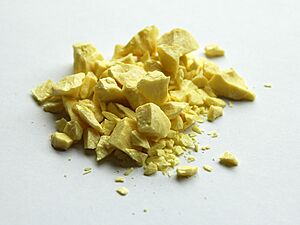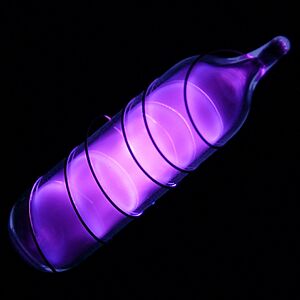Period 3 element facts for kids
A period 3 element is a special type of element found on the third row, also called a period, of the periodic table. Think of the periodic table as a big chart that organizes all the known elements in the universe!
There are eight elements in this third row: sodium, magnesium, aluminium, silicon, phosphorus, sulfur, chlorine, and argon. Each of these elements has unique properties and uses.
Contents
What is the Periodic Table?
The periodic table is a super important chart in chemistry. It helps scientists and students understand how different elements are related. Elements are the basic building blocks of everything around us, from the air we breathe to the devices we use.
The table organizes elements based on their atomic number (the number of protons in their atoms) and their chemical properties. Elements in the same row (period) have the same number of electron shells, while elements in the same column (group) have similar chemical behaviors.
Why are Elements in Periods?
Elements are placed in periods because of their electron shells. Imagine an atom like an onion, with layers around its center. These layers are called electron shells. Each shell can hold a certain number of electrons.
- Elements in Period 1 have one electron shell.
- Elements in Period 2 have two electron shells.
- Elements in Period 3, like the ones we're talking about, have three electron shells.
Even though they all have three shells, the way their outermost electrons are arranged changes as you move across the period. This change makes each element behave differently.
Meet the Period 3 Elements
Sodium (Na)
Sodium is a soft, silvery-white metal that reacts very strongly with water. You might know it best as part of table salt (sodium chloride). Sodium is also super important for your body, helping with nerve signals and muscle function. It's often used in streetlights, making them glow with a bright orange light.
Magnesium (Mg)
Magnesium is a light, silvery-white metal. It's known for burning with a very bright, white flame, which is why it's used in fireworks and flares. Magnesium is also vital for your health, helping your muscles and nerves work properly. It's found in many common products, like some antacids and even in the chlorophyll that makes plants green!
Aluminium (Al)
Aluminium is a lightweight, strong, and corrosion-resistant metal. It's one of the most common metals on Earth and is used for so many things! Think about soda cans, airplane parts, and even foil for cooking. Its ability to resist rust makes it very useful for outdoor structures and vehicles.
Silicon (Si)
Silicon is a shiny, dark gray material that is a metalloid. This means it has properties of both metals and nonmetals. Silicon is incredibly important in modern technology. It's the main material used to make computer chips, solar cells, and many electronic devices. Sand and quartz are mostly made of silicon dioxide.
Phosphorus (P)
Phosphorus is a nonmetal that exists in several forms, including white, red, and black. White phosphorus is very reactive and glows in the dark! Phosphorus is essential for all living things; it's a key part of DNA, bones, and tooths. It's also used in fertilizers to help plants grow and in safety matches.
Sulfur (S)
Sulfur is a bright yellow nonmetal that has a distinct smell, especially when it's burned (think of rotten eggs!). It's found naturally near volcanoes. Sulfur is used to make sulfuric acid, which is one of the most important industrial chemicals. It's also used in fertilizers, medicines, and even in rubber to make it stronger.
Chlorine (Cl)
Chlorine is a greenish-yellow gas that is very reactive. It's commonly used as a disinfectant to kill germs, especially in swimming pools and to purify drinking water. Chlorine is also used to make many everyday products, like plastics (PVC) and cleaning supplies.
Argon (Ar)
Argon is a noble gas, which means it's very unreactive and doesn't easily form compounds with other elements. It's the third most common gas in Earth's atmosphere. Because it's so unreactive, argon is used to fill light bulbs to prevent the filament from burning out quickly. It's also used in welding to protect metals from reacting with air.
See also
 In Spanish: Elementos del periodo 3 para niños
In Spanish: Elementos del periodo 3 para niños



